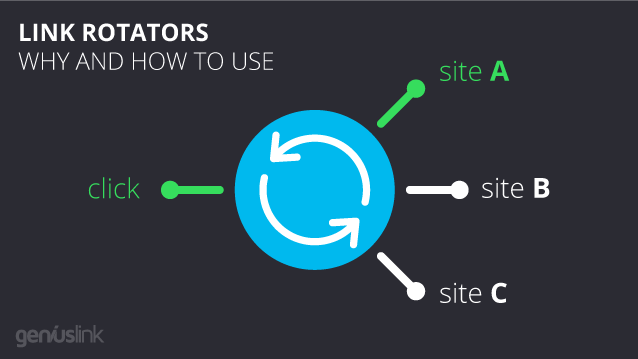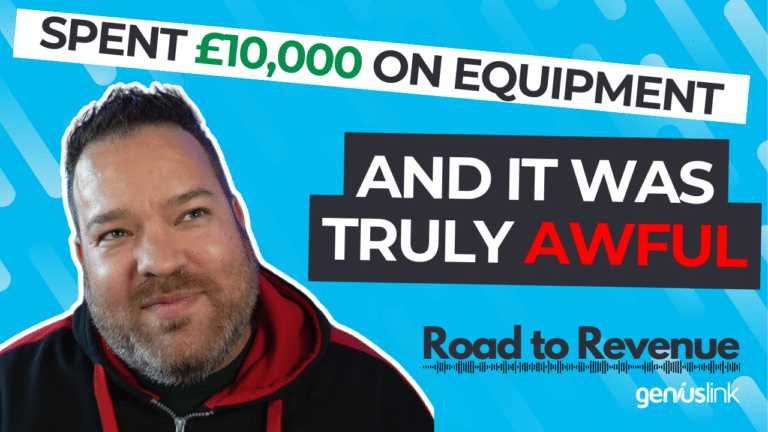How to Use a Link URL Rotator (And Why You Should)
-
Mario oversees all of our growth initiatives, everything from our booth at the Farmer’s Market to our content and paid acquisitions efforts. Before coming to Geniuslink, Mario was the CMO at the University of Montana and prior spent 10 years running digital strategy divisions for WONGDOODY and R2C Group. In his free time, Mario loves geeking out on his side projects IdeaMensch and Seniorlevel.
- August 30, 2023

Twenty years into my career, I am now just writing my first post about link rotators.
What’s the saying? “What got me here isn’t going to get me where I want to go.” Case in point – Mario’s content strategy.

Link rotators are actually cool. Once you start using them, you tend to be surprised by their utility and wonder why you didn’t try them earlier.
What is a Link Rotator?
A link rotator is a unique link that allows you to route traffic to different destinations.
It’s that simple.
Yet, the impact of using a link rotator can be dramatic.
Why?
Because it allows testing some level of efficacy resulting from sending the traffic to destination A vs. destination B.
It’s like a clinical trial for landing pages – minus the placebo. Or, an A/B test as is more common verbiage amongst the web marketing crowd.
Why would you want to use link rotation?
Here is the problem and question many people try to answer.
Am I maximizing my revenue by sending traffic to location A.
And/or could I possibly earn more income if I sent the same amount of traffic to location B?
By location, often, we’re referring to landing pages.
This is the most common usage of link rotators for web marketers.
When people hear about A/B testing, it usually means driving equal amounts of traffic to two different landing pages to determine which has a higher conversion rate.
There are other variables to test when using link rotation to drive visitors to different landing pages, such as offer testing.
Let’s say you’re in the business of beef jerky. You could drive 50% of your traffic to a landing page selling a 10z package while sending another to a landing page selling a 12oz package of the same product.
Or you could test different price points, $5.99 vs. $6.99 for the same product tested via separate landing pages.
One-time sale vs. subscription is another interesting test.
At that point, conversion rate might not be the only metric you’re testing. You might be more concerned about metrics such as average order size or even lifetime value.
This stuff can be as complicated as you want it to be. My recommendation is always to keep it simple and start with the experiment that you’re most wanting to know the answer for. You know the old saying:
“No FOMO when it comes to link rotations.”
Anyhow, here at Geniuslink, we work with a ton of fantastic affiliate marketers. And those affiliate marketers have one other usage of link rotators that is a little more uncommon.
I will tell you what it is in a moment because it’s almost like a secret. Once I reveal that secret, I will give you an even better strategy which is almost unfair now that I am reading this.
One fantastic use case for link rotators for affiliate marketers is to drive affiliate equal amounts of traffic to two different storefronts (like Walmart and B&H Photo Video, for example) and then see which storefront sold more products and/or earned you more commissions. Too often, we blindly drive traffic to certain storefronts without knowing whether or not we might be leaving money on the table.
However, there is a problem with this strategy. Because many affiliate programs, such as Amazon, forbid you from technically using a link rotator as you have to properly disclose the destination and purpose of the link (such as Amazon Affiliate Link).
So while we recommend that everybody test different affiliate storefronts via link rotation, there is a better way of doing that.
And that way is to use Choice Pages. A Choice Page is an interstitial landing page that allows you to offer your visitors/viewers/fans a couple of different storefront options for the same product.
You’ll find out that different buyers prefer different storefronts, allowing you to ultimately maximize the amount of commission you can earn from every click. While it’s not precisely an A/B test, it will provide you with the kind of knowledge that’s bound to help you increase your revenue.

And here is the thing, which sounds crazy as I type this, but many of our clients are seeing increased affiliate commissions from Amazon by simply offering shoppers more choices.
It seems that people are more likely to buy when you present them with a variety of options, even if you’re not showing them prices from the different websites.
One last thing, since I brought up the topic of disclosure, but Choice Pages are great at allowing you to include all the necessary affiliate disclosures without using valuable real estate wherever you might be sharing your affiliate links.
And you don’t have to ask; here is some information on how to set-up a link rotator with Geniuslink, excerpted from this post.
Additionally, here is a video we put together on this very topic. Or, feel free to follow along in the steps below.
To create an A/B Split Test link, simply navigate the links tab, click “New.” and select “A/B Split.”

This will bring up the link options page, where you can specify multiple destination URLs and the percentage of traffic you’d like directed to each. You can add more destination URLs by clicking “Add another destination.”

Add your destination URLs, specify the percentage of total traffic you want to be directed to each destination, and click save. (Please note: percentages must add up to 100%)

Your intelligent link with Split Testing is now ready for the world! Use this link to learn more about how different destinations perform for your audience.
Author
-
Mario oversees all of our growth initiatives, everything from our booth at the Farmer’s Market to our content and paid acquisitions efforts. Before coming to Geniuslink, Mario was the CMO at the University of Montana and prior spent 10 years running digital strategy divisions for WONGDOODY and R2C Group. In his free time, Mario loves geeking out on his side projects IdeaMensch and Seniorlevel.
Author
-
Mario oversees all of our growth initiatives, everything from our booth at the Farmer’s Market to our content and paid acquisitions efforts. Before coming to Geniuslink, Mario was the CMO at the University of Montana and prior spent 10 years running digital strategy divisions for WONGDOODY and R2C Group. In his free time, Mario loves geeking out on his side projects IdeaMensch and Seniorlevel.
Related posts

What is a Geni.us Link?

Building Diverse Income Streams with Doug Cunnington

Building Wealth Through Video with Matt Hughes

Can you Include Affiliate Links in Emails?
More revenue from every link you share
Geniuslink makes localizing, tracking, and managing smart links dead simple, so you can earn more without added work.
